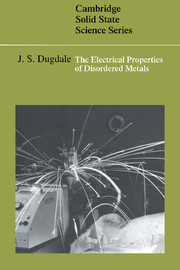Book contents
- Frontmatter
- Contents
- Preface
- 1 Context and content
- 2 Production and structure of metallic glasses
- 3 Electron transport in metals: introduction to conventional theory
- 4 Scattering
- 5 Simple liquid metals: Ziman theory
- 6 Phonons in disordered systems
- 7 Interactions and quasi-particles
- 8 Transition metals and alloys
- 9 The Hall coefficient of metallic glasses
- 10 Magnetoresistance
- 11 Electrical conductivity of metallic glasses: weak localisation
- 12 The interaction effect or Coulomb anomaly
- 13 The effect of the Coulomb interaction on conductivity
- 14 Influence of a magnetic field on the enhanced interaction effect
- 15 The thermopower of metals and alloys
- 16 Comparison with experiment
- Appendices
- Notes
- References
- Index
5 - Simple liquid metals: Ziman theory
Published online by Cambridge University Press: 21 January 2010
- Frontmatter
- Contents
- Preface
- 1 Context and content
- 2 Production and structure of metallic glasses
- 3 Electron transport in metals: introduction to conventional theory
- 4 Scattering
- 5 Simple liquid metals: Ziman theory
- 6 Phonons in disordered systems
- 7 Interactions and quasi-particles
- 8 Transition metals and alloys
- 9 The Hall coefficient of metallic glasses
- 10 Magnetoresistance
- 11 Electrical conductivity of metallic glasses: weak localisation
- 12 The interaction effect or Coulomb anomaly
- 13 The effect of the Coulomb interaction on conductivity
- 14 Influence of a magnetic field on the enhanced interaction effect
- 15 The thermopower of metals and alloys
- 16 Comparison with experiment
- Appendices
- Notes
- References
- Index
Summary
k-states in disordered metals
The simplest amorphous metals are probably the liquid non-transition metals such as liquid sodium or liquid zinc. The simplicity arises partly because no d-electrons are involved and partly because the liquids are of a single component whereas by contrast all metallic glasses involve at least two components. So let us see how far we can understand the electron transport of these amorphous metals before we tackle systems with the additional complication of two or more components.
As soon as we confront the problem of electron transport in highly disordered systems like liquids or glasses several questions spring to mind. How useful is the concept of a k-state when we are so far from having translational symmetry? How valid is the concept of a Fermi surface? The answers depend, not surprisingly, on the degree of scattering involved. Thus it is not just the degree of disorder involved but also the strength of the individual scattering processes. If the mean free path of the electrons is l and the electron wavelength at the Fermi level is λ we require that l be much greater than λ. More commonly we choose the almost equivalent condition kFl ≫ 1 where kF = 2π/λ. In a highly disordered system the mean free path tends to be only weakly temperature dependent so that the condition itself is essentially temperature independent. Experience with other systems of limited mean free path, for example, calculations on concentrated random binary crystalline alloys which give results in accord with experiment, suggests that a Fermi surface and its associated k-vectors for the conduction electrons are useful and satisfactory concepts provided that kFl≫ 1.
- Type
- Chapter
- Information
- The Electrical Properties of Disordered Metals , pp. 48 - 54Publisher: Cambridge University PressPrint publication year: 1995



